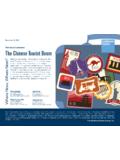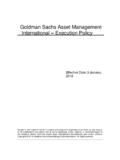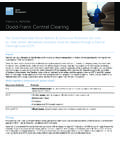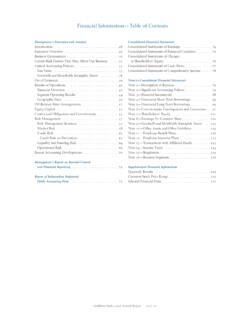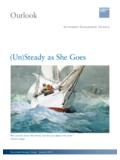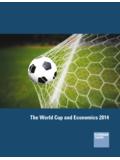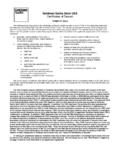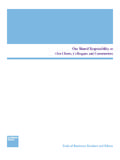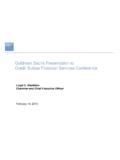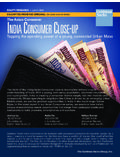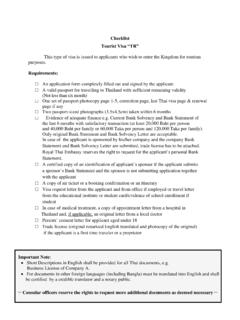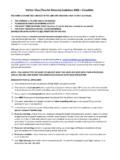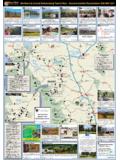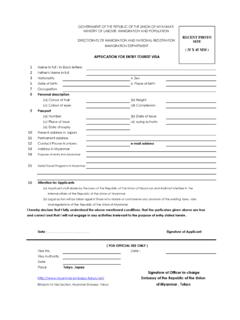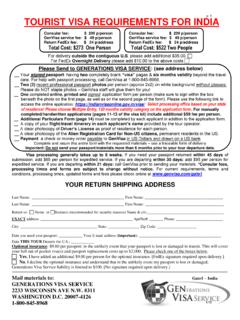Transcription of 5IF TJBO $POTVNFS The Chinese Tourist Boom
1 Goldman Sachs does and seeks to do business with companies covered in its research reports. As a result, investors should be awarethat the firm may have a conflict of interest that could affect the objectivity of this report. Investors should consider this report as only asingle factor in making their investment decision. For Reg AC certification and other important disclosures, see the Disclosure Appendix,or go to Analysts employed by non-US affiliates are not registered/qualified as research analysts withFINRA in the Goldman Sachs Group, ,BXBOP TIP LBXBOP!HT DPN (PMENBO 4 BDIT +BQBO $P -UE 3 JDLZ 5 TBOH $'" SJDLZ UTBOH!HT DPN (PMENBO 4 BDIT "TJB - - $ +JOHZVBO -JV KJOHZVBO MJV!HT DPN (PMENBO 4 BDIT +BQBO $P -UE The Chinese Tourist BoomWhere Now, Where Next?November 20, 2015 China s outbound tourism is set to bloom over the next 10 years and leave its mark on a wider range of destinations. Fueled by experience-hungry millennials and a growing middle class, the number of Chinese passport holders is forecast to swell by 100 million over the decade equal to almost all US outbound tourists today.)))
2 While Hong Kong and Macau will remain important destinations, the surge will lead to dramatic increases in visitors to destinationT across Asia, Europe and beyond. +PTIVB -V KPTIVB MV!HT DPN (PMENBO 4 BDIT "TJB - - $ 5IF "TJBO $POTVNFS November 20, 2015 Asia Pacific: Retail Goldman Sachs Global Investment Research 2 Table of contents Chinese tourism in eight charts 4 Overview: Six key questions 6 Chinese tourism by numbers 8 Q1: How many could travel? 11 Q2: Who are they? 14 Q3: Why do they travel? 21 Q4: Where do they go? 25 Q5: Is capacity an issue? 41 Q6: What could slow the tide? 52 Appendix 64 Disclosure Appendix 66 This is an abridged version of The Chinese Tourist Boom: Where Now, Where Next? originally published November 20, 2015. Analyst team contributors AnalystTelephoneEmailAnalystTelephoneEma ilJapan RetailHong Kong RetailSho Kawano+81 (3) 6437 Lu+852 2978 Liu+81 (3) 6437 Tsang+852 2978 Lee+852 2978 Hotel/REITHong Kong ConglomaratesSachiko Okada+81 (3) 6437 Cheung+852 2978 Watanabe+81 (3) 6437 Ye+852 2978 TransportationHong Kong TransportationKenya Moriuchi+852 2978 Keung+852-2978-0856 Okada+81 (3) 6437 RetailEU RetailChristine Cho+82 (2) 3788 Hutchings+44 (20) 7051 Lee+82 (2) 3788 Zhang Zhang+44 (20) 7552 RetailUS RetailMichelle Cheng+866 (2) 2730 Fassler+1 (212) 902 Chang+65 6654 Drucker Mann+1 (212) 357 RetailUS LeisureJune Zhu+65 6889 Kent+1 (212) 902 Ahwoi+1 (212) 902 Kong Internet/MediaDavid Jin+852-2978-1466 20, 2015 Asia Pacific: Retail Goldman Sachs Global Investment Research 3 The Chinese Tourism Boom: By the Numbers4%The passport-owning population in China (vs.))
3 35% in the US). We expect this figure to reach 12% within 10 years. (Page 16)PASSPORT POTENTIAL28%MIDDLE-CLASS MOBILITYThe percentage of outbound Chinese tourists from the urban middle class, compared to just 3% from the urban mass. (Page 17) GRADUATE AND GOThe number of travel-ready millennials who will graduate from Chinese universities in the next 10 years. (Page 18)74 mn220 mnTHE 10-YEAR TRAVEL OUTLOOKThe number of Chinese residents who will travel overseas in 2025, up from 120 mn this year. (Page 13) 70 mnHEADED TO HONG KONG AND NOWThe number of Chinese travelers who will visit Hong Kong and Macau in 2015 two destinations that don t require a passport. (Page 27)NEXT STOP(S): JAPAN AND BEYONDThe number of Chinese residents who will visit Japan in 2025, up from 5mn in 2015. We also expect Korea, Australia and Europe to become Tourist hot spots. (Page 26)16 mnThe average amount that Chinese residents spend on having more fun. This is less than 10% of the per capita amount in the US, Japan and Korea, but poised to grow as China spends more on leisure.
4 (Page 24) HAVING FUN BUDGET$230/yrThe average cost of a package tour to Japan, including money spent on shopping ($1,000). (Page 21)$2,000 VACATION COSTSThe amount Chinese tourists will spend on travel overseas in 2025, an increase of $250 bn from today s figures. (Page 35)THE ACCOMPANYING RETAIL BOOM$450 bnThe discount Chinese tourists can expect when shopping in Japan, Korea and Hong Kong, adding to these locations appeal. (Page 39)20-30%BARGAIN HUNTING3 hoursThe flight time from Shanghai to Tokyo. Chinese tourists can fly to most Asian countries in four hours or less. (Page 29)UP IN THE AIR45 VISA RESTRICTIONS LIMIT TRAVELThe number of countries that offer Chinese tourists visas upon arrival. In contrast, 172 countries offer visas on arrival for Japanese and Korean tourists. (Page 60)November 20, 2015 Asia Pacific: Retail Goldman Sachs Global Investment Research 4 Chinese tourism in eight charts Exhibit 1: We estimate only 4% of the Chinese population owns a ownership by country Exhibit 2.
5 As such, we expect Chinese Tourist numbers to keep Chinese Tourist growth outlook by destination (GSe) Source: CEIC, Goldman Sachs Global Investment Research. Source: Goldman Sachs Global Investment Research. Exhibit 3: ..potentially to 130 mn vs. 50 mn in 2015 (ex. Hong Kong/Macau) Chinese Tourist volume to Hong Kong/Macau, and other regions Exhibit 4: Fun related spending is under-indexed in Comparison of per-capita spending on having fun (FY2013, US$) Source: CEIC, Goldman Sachs Global Investment Research Source: Euromonitor 55150109324%12%35%25%0%5%10%15%20%25%30% 35%40%020406080100120140160 China (2014E) China (2025E)US (2012)Japan (2014)Total passport holders (mn)as % of population (RHS)Assuming therun rate continues at 10mn passports (mn)2015E2025 1999 2000 2001 2002 2003 2004 2005 2006 2007 2008 2009 2010 2011 2012 2013 2014 outbound tourists over time (mn)Passport Destinations (lhs)HK & Macau (lhs)Growth of Total (rhs) CAGR2209%16%17%18%0%2%4%6%8%10%12%14%16% 18%20%ChinaJapanUSKoreaNovember 20, 2015 Asia Pacific: Retail Goldman Sachs Global Investment Research 5 Exhibit 5.
6 74 mn millennial college grads in next 10 years is a key driver Breakdown of Chinese overseas tourists by generation (2014) Exhibit 6: Various countries are relaxing visa requirements Source: World Tourism Cities Federation Source: Goldman Sachs Global Investment Research. Exhibit 7: Japan: Passport issuance is a more important driver of outbound travel growth than the economy Japan: No. of overseas tourists and no. of passports issued Exhibit 8: Key risks to passenger growth mainly surround pricing and potential visa changes Source: Goldman Sachs Global Investment Research. Source: Goldman Sachs Global Investment of college grads in the coming decade Post 90s, 11%Post 80s, 56%Post 70s, 26%Post 60s and born before 60s, 6%Asia PacificJapan, Korea, Taiwan, Thailand, Indonesia, Singapore, AustraliaEuropeUK, France, GermanyAmericaUSCountries relaxing requirments for Chinese tourists0%5%10%15%20%25%30%35%40%45%50% of passport issued (lhs, mn)Outbound (lhs, mn)Passport holder % population (GSE, rhs, %)FX ratesMay impact the pricing advantage of key destinations ( HK, Japan Korea), although the relationship between visitor numbers and FX may be more limited in the fast-growth stageVisa policiesHK and Macau saw significant declines in Chinese Tourist numbers on visa tightening and are typical examples of the riskBrands cutting pricesTariff/tax cutsRisk factorsWould impact the selling prices of products in China, hence affecting the attractiveness of buying goods in other countriesNovember 20, 2015 Asia Pacific.
7 Retail Goldman Sachs Global Investment Research 6 Overview: Six key questions Q1: How many could travel? We estimate 120 mn Chinese tourists will travel overseas in 2015, with mn traveling to Hong Kong/Macau, around 5 mn to Japan, Korea, and Taiwan, 12 mn to ASEAN, and 2 mn to the US. We expect the number of outbound passengers to almost double to 220 mn in 2025. If we exclude Hong Kong and Macau, we expect Chinese Tourist numbers to increase times to 130 mn in 2025 from 50 mn in 2015. Q2: Who are they? They are somewhat affluent: We estimate 28% of the urban middle cohort has a passport vs only 3% for the urban mass . Per head spending on travel is US$1,400 equal to 1-2 month s salary for a typical middle-class worker. They are young: Two thirds of current outbound travelers are millennials (15-35 years old). We expect the 74 mn college students graduating over the next decade to further boost passport ownership. Q3: Why do they travel?
8 To have fun: Millennials are aspirational, leading to structural upside in fun related experience based spending. This includes sports, travel, online gaming, media and eating out. Fun related spending is under-indexed in China, at 9% of per capita expenditure vs 16-17% in the US and Japan. To shop: In the short-term, we still see shopping as a one of the key drivers for Chinese tourists when selecting travel destinations. Chinese tourists spent US$200 bn (US$ 450 bn in 2025) in overseas spending in 2015 and 30% was on shopping. The number of travelers should increase on three key drivers: (1) a passport ownership rate of just 4%, (2) a growing urban middle class which is increasingly willing to spend more on fun, and (3) the boost from millennials travel. Q4: Where do they go? Today s HK is tomorrow s Japan/Korea: We expect high outbound traveler growth to Japan, considering multiple factors such as the relatively short travel distance from China, price differentials, relaxing visa conditions, and tourism assets.
9 Distance: Many Asian countries are just a three to four hour flight from China, much closer than European and North American countries. However, many countries require visas for travel from China, making them seem even further away. Relaxation of visas: A number of key countries have already relaxed (or are in the process of relaxing) visa requirements for Chinese tourists over the past 18 months, which could help boost Tourist numbers. The addressable market of Chinese tourists to Japan has increased to mn Chinese residents from <10 mn following a visa change in January 2015. November 20, 2015 Asia Pacific: Retail Goldman Sachs Global Investment Research 7 Price differentials: Our proprietary GS Tourist price tracker suggests that prices of merchandise in China are more expensive than HK, Japan and Korea on average. The greatest differences are mostly for goods, not services a Zojirushi rice cooker is more than 2X expensive in Shanghai vs Tokyo, but a taxi ride is 80% cheaper.
10 Tourism assets: This is becoming an increasingly important driver of tourism, as millennial travelers crave fun. Japan has the second highest number of world heritage sites in Asia after China, making it an attractive destination for Chinese tourists. Hong Kong, on the other hand has had limited additional attractions since Disneyland. Q5: Is capacity an issue? Countries set to experience high inbound Tourist growth from China have sufficient capex plans for both hotels and airports but Japan is lacking sufficient hotels. We do not anticipate any major capacity issues in HK, and Korea s airport/hotel expansion plans are enough to support double-digit Chinese inbound growth CAGR, in our view. Q6: What could slow the tide? China economic slowdown? Looking at past experiences in Japan, the UK, Korea, and others, suggests overseas travel has a higher correlation with passport growth than the economy. Given only 4% of China s population has a passport at present, we think it is far too early to say there will be a change in the overall upward trend, even if the economic slowdown has more than a slight impact.
